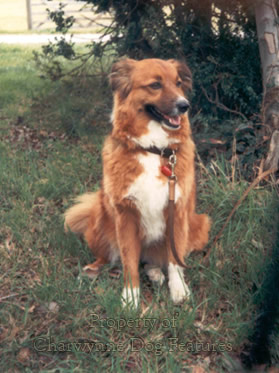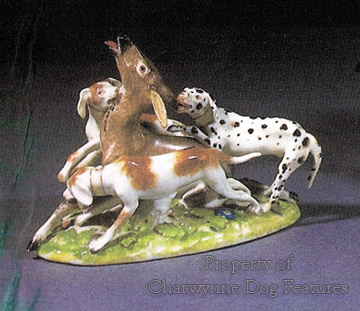940 DOES A BREED'S HISTORY MATTER
DOES A BREED'S HISTORY MATTER?
by David Hancock


.jpg)

For every Kennel Club-registered breed, there is, in its Breed Standard, a brief summary of its history, and often reference to its historic function, in its stipulations. This is no doubt intended to assist the breed's fanciers in breeding for function and respecting origins. That is an honourable intention but one that relies entirely on a combination of accuracy and honesty, accuracy in getting the breed's history right and honesty in perpetuating that history in the contemporary breed. In far too many breeds of purebred dog however, the 'history' has been handed down from Victorian plagiarists, is rooted in poor research and perpetuated falsehoods, mostly fancifully-conceived out of misplaced romanticism. Badly-named breeds are harmful enough; wrongfully-provenanced breeds get cast in the wrong mould - with the kennel clubs of the world being the culprits far too often. There seems little coordination at the international level and yet there is an organisation to do just that: the FCI (Federation Cynologique Internationale).
.jpg)


It's the nouns that suffer most! When is a terrier truly a terrier in its breed title? Not when it's a Tibetan Terrier, that's for sure. And how can a two-foot-high breed be dubbed a 'terrier'? The Airedale came from an Otterhound origin and like the Russian Black was never bred for the earth-dog role. What defines a shepherd dog? Is it breed title or function? Do the shepherd dogs, so called, of Germany, Belgium, Australia and Anatolia have the same function? No, they do not and it's misleading and unnecessarily so. Similarly with the mountain dogs, the term has been loosely applied or omitted when it should be bestowed, as in the St Bernard. Is a spaniel a gundog or a Toy breed? Both by breed title and by grouping, each name should dictate a quite different build - from historic function. But linking a breed title firmly and eternally with a country really should be well-proven or its important origins, and subsequent development, will be quite wrongly based. This can influence both design and eventual appearance. 
It could be argued that the Labrador Retriever is the Devon Fishing Dog relocated, as Richard Wolter, in his book on the breed, has persuasively recounted. Those who scoff at his research seem content to accept the quite absurd theory that Breton fishermen transported Pyrenean Mountain Dogs in their small boats to North America to found the breed of Newfoundland. Several breeds are alleged to have been founded by escapees from ship-wrecks off Ireland or Chesapeake Bay. Few argue that the Chesapeake Bay Retriever is in fact the old Norfolk Retriever taken there by colonists or that the Nova Scotia Duck Tolling Retriever is likely to be the Red Decoy Dog of East Anglia taken on the same pathway. For most of a century the quaint tale of the Golden Retriever being based on circus dogs from Brighton seemed acceptable to breed fanciers. The linking of the Bearded Collie with Polish look-a-likes, yes, off a grain ship visiting Scotland from Poland, seemed to appeal to some gullibles, despite the Beardie being described and depicted in Northern Britain long, long before such an alleged incident could have occurred. 
But the 'killer' is probably the case of the Dalmatian, assumed to be linked with the country of that name, without any real evidence, but plenty of nationalist fervour behind the claims. My theory that the breed name comes from the expression 'dama-chien' or deer-dog, and supported by plenty of artistic evidence, is worthy of more scrutiny. The theory, found to have been 'invented' by a lazy writer a century ago, that the Australian Cattle Dog had Dalmatian blood was superbly refuted by the diligent researches of Noreen Clark, and set out in her excellent book A Dog Called Blue. I supplied her with images of working collies here to illustrate the merled, spotted and flecked sheepdogs shipped to Australia in the 19th century. Yet still come the writings of Pyrenean sheepdogs being behind such an introduction there. I lobbied the FCI for some years to get breed histories authoritatively set out, but then the grouping of breeds by them and their constituent clubs is no help.
Dividing the Hounds into just Scent- and Sight-Hounds has created more problems than it has solved. Are the hounds of the Mediterranean littoral, like the Ibizan, Sicilian, Cretan and Maltese dogs, sighthounds or scenthounds? They hunt very cleverly using, sight, scent and, especially, their acute hearing. And to call the graceful but efficient Maltese Rabbit Dog (its Maltese name!) a Pharaoh Hound, just displays the ignorance of the bodies concerned in this entitling. One influential and remarkably persuasive British breed-advocate achieved that! Why are the heavy hounds, the mastiff breeds, not recognized as hounds by kennel clubs? Their bravery in hunting big game in the primitive hunt was just astounding. This has meant that the German Boarhound, the Great Dane of today, languishes in the Working Group, whereas it should be The King of the Hounds. Weirdly not listed as hounds are the two South American breeds, created and developed to hunt the jaguar: the Fila Brasiliero and the Dogo Argentino. But then, the Dachshund, designed as an earth-dog or terrier is categorized as a hound. This doesn't help those striving to reconcile origins and function with physical design.
In my book The Mastiffs - The Big Game Hunters I set out the essential differences between mastiffs and molossers, and they are different! The Molossians had two types of dog: a livestock protection dog like the big Greek Sheepdog of today, and a big hound, the Suliot Dog, used in the boar-hunt, and represented by the Great Dane of today. The Molossian people did not have short-faced, seizing dogs such as the mastiff breeds of today, but they knew of them - calling them Hyrcanian Dogs. I argued this point with the FCI for many years. I also pointed out that the Finnish Spitz is a clever gundog not a hound, without success. It now resides in the Hound Group and probably always will! But then, who will convince the show ring fanciers that the smaller breeds of Schnauzer and Pinscher would be better bred and judged as terriers? If history, reflected in breed titles, is to play a role in how breeds are perpetuated, then exaggerated show ring types such as the Bulldog could be improved and made so much healthier. If you study the depictions of the sickening, so-called 'sport' of bull-baiting, and there are plenty of such depictions by artists famed for their accuracy, you can quickly see that the baiting dogs were much more like today's Staffordshire Bull Terriers than any Bulldog, then or since. Bulldogs were farmers' dogs, used to pin wayward cattle, both in the farmyard and en route to the abattoirs. They were valuable; baiting dogs were, sadly, expendable.

I look forward to the day when, at a Hound Show like Peterborough, or at the various Game Fairs or even, dare I say, on the first day of Crufts, a parade of hounds is accompanied by this commentary: "And now, Ladies and Gentlemen, we welcome into the ring our precious hound breeds. First come those which hunt by speed: the Whippet, the Greyhound, the Saluki, the Borzoi and the Deerhound. Then those which hunt by stamina: the Basset, the Beagle, the Foxhound and the Harrier . Next come those which hunted 'at force': the Great Dane, the Rhodesian Ridgeback, the Dogo Argentino and the recently introduced Black-Mouthed Cur from America. Finally, the seizing and holding dogs, the hunting mastiffs: the Dogue de Bordeaux, the Fila Brasileiro, the Cane Corso and, last but hardly least, the British Bulldog!" Eyebrows would be raised - but so too would the honesty in the breeding of breeds in the future, and the breeds themselves would be better for that. Breed history does matter!